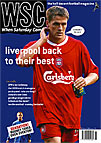 Fulham fans are desperate to return to Craven Cottage, but maybe it is not viable. Neil Hurden investigates
Fulham fans are desperate to return to Craven Cottage, but maybe it is not viable. Neil Hurden investigates
Braving Arctic weather and pavements more slippery than Nicolas Anelka’s agent, 400 Fulham fans attended the Back to the Cottage Campaign’s public meeting on January 30. The venue, Hammersmith Town Hall, is a place intimately linked with the struggle for Craven Cottage’s survival: 16 years ago it saw the noisy birth of the campaign which fought off the Fulham-QPR merger plan. Now we were back, a little more subdued and confused but not without hope that London’s oldest and, in our view, finest ground can still be preserved.
The position now is not as morally clear-cut as the old battle between fans and developers. New external factors have impinged, notably the requirement to have all-seat stadiums and the general inflation in the costs associated with top-division football. Overshadowing every thing else, though, is the role of the chairman. Only five years ago, the very thought of Premiership football would have had the notorious cynics of the Stevenage Road Enclosure losing control of their thermos flasks in their amusement.
Recent events – particularly the news of the conditional sale of the site to Fulham River Properties back in September – have damaged trust between fans and club. Yet a major feature of the meeting was the degree of hope still at large that the chairman can be persuaded a return to the Cottage is in everyone’s interests.
Hammersmith and Fulham council leader Andrew Slaughter provided some encouragement by stressing that the unitary development plan was geared towards affordable social housing. Any development of the whole site would have to include at least 50 per cent social housing, a clear disincentive to the luxury riverside flats brigade. He also emphasised that the site was designated for usage as a place for playing football. He warned, though, that these policies could be overturned if there was a change of political control and the current administration’s planning decisions could be appealed by determined developers.
The clear majority opinion of the meeting appeared to be that a conciliatory approach had to be made to Mohamed Fayed. Certainly the views expressed by those who had worked for him who attended – including a rather bizarre contribution from his bouffonted former spokesman, Michael Cole – was that he had thrived on the support of the fans since he took over in 1997 and would listen reasonably to a well thought out plan for a return to the Cottage.
There is a serious strategic difference between the BTTC campaign, who represent more traditional fans, and the more ambitious line taken by the club, which would probably be supported by some of the newer fans with less emotional attachment to the Cottage.
The campaign fully accepts that if a return to a developed Cottage site is feasible, it has to be done on a more modest scale than the plans approved earlier which the club now says are too expensive to pursue. The logic is that security and stability are more important than the ever increasing costs of chasing success on the pitch. You can break this down to the question of whether you would rather see Fulham play at the Cottage in a lower division or play elsewhere in the Premiership – though the question does not necessarily have to be an either/or, for, as clubs such as Charlton have shown, it is possible to become established in the top division with crowds of around 25,000.
The challenge is to persuade the one man capable of keeping Fulham alive financially to restrain his naturally ambitious approach to business in the interests of longer-term development. This strategy may not promise a particularly glamorous route to success, but at a time when a club like Leeds can get into serious financial difficulties, a stable home and the support of a contented fan base would surely provide a more secure foundation.
From WSC 193 March 2003. What was happening this month